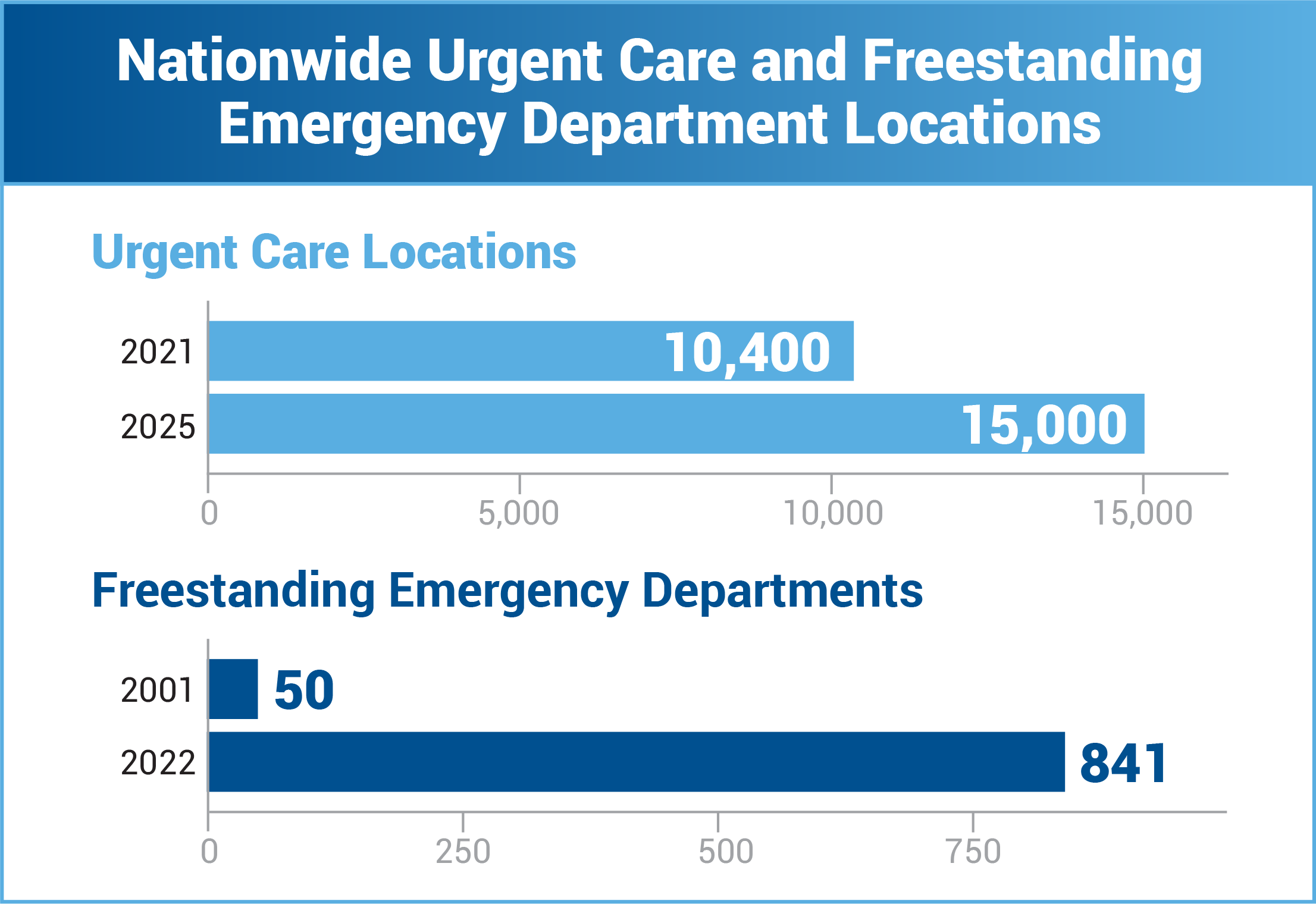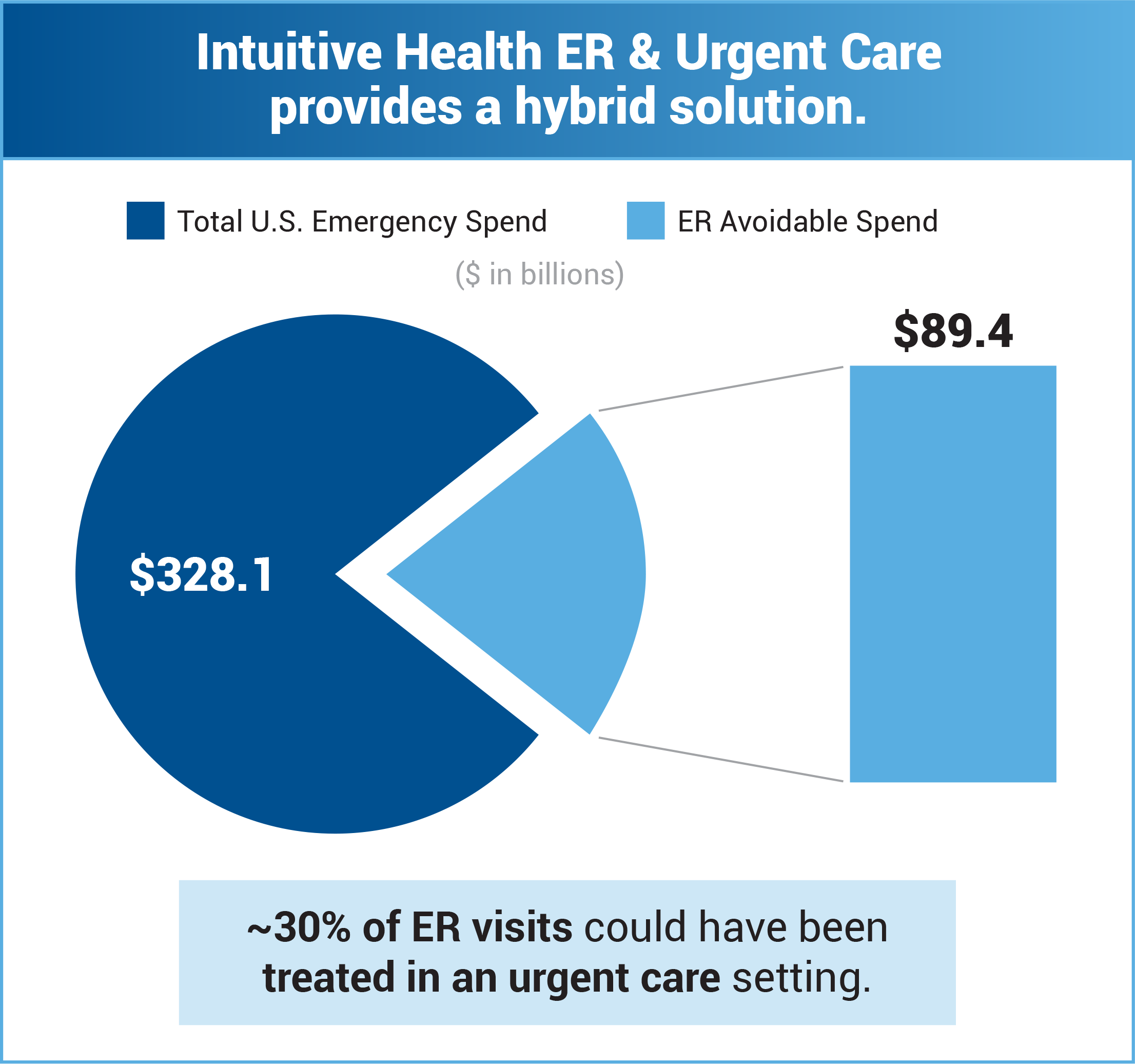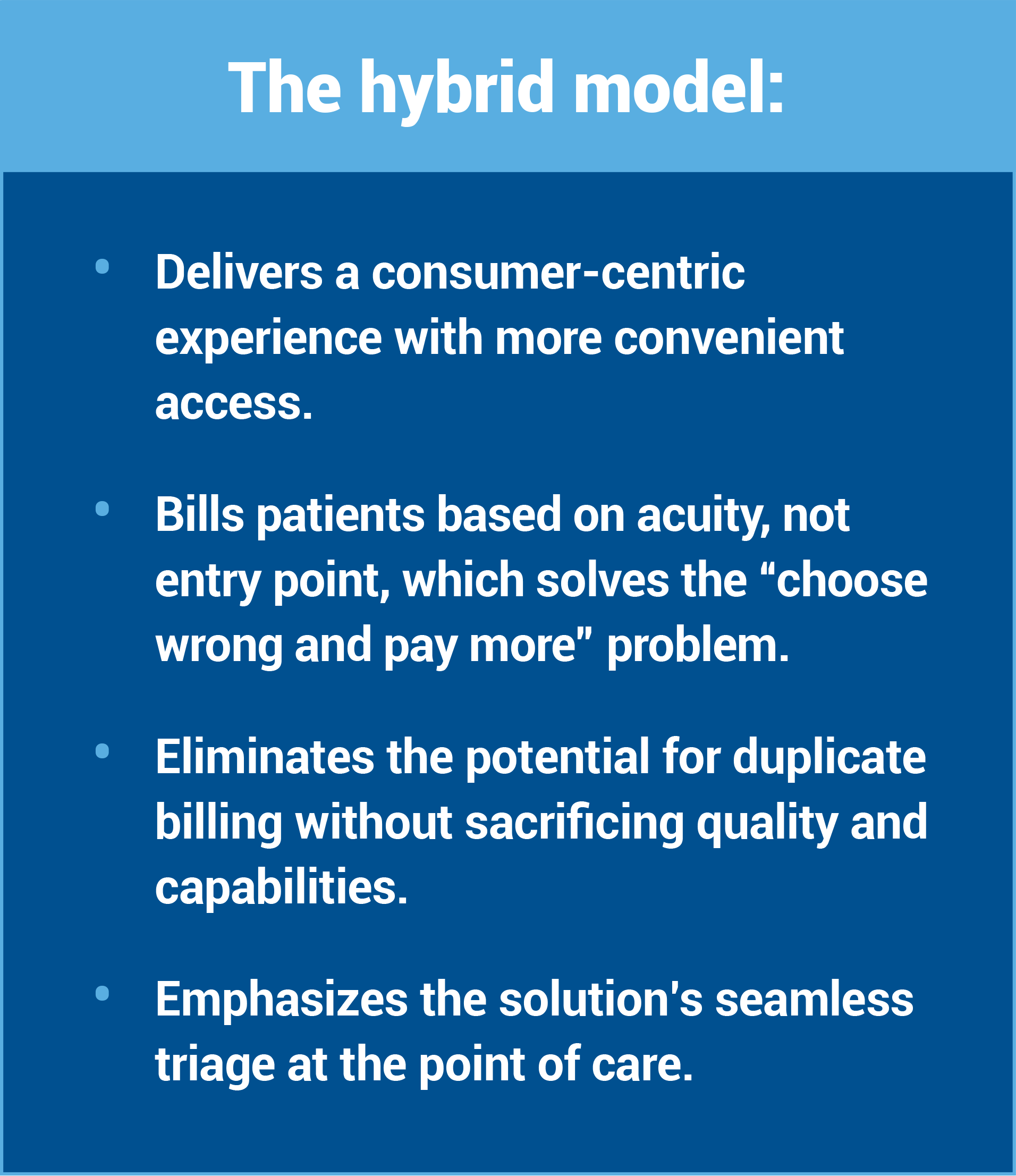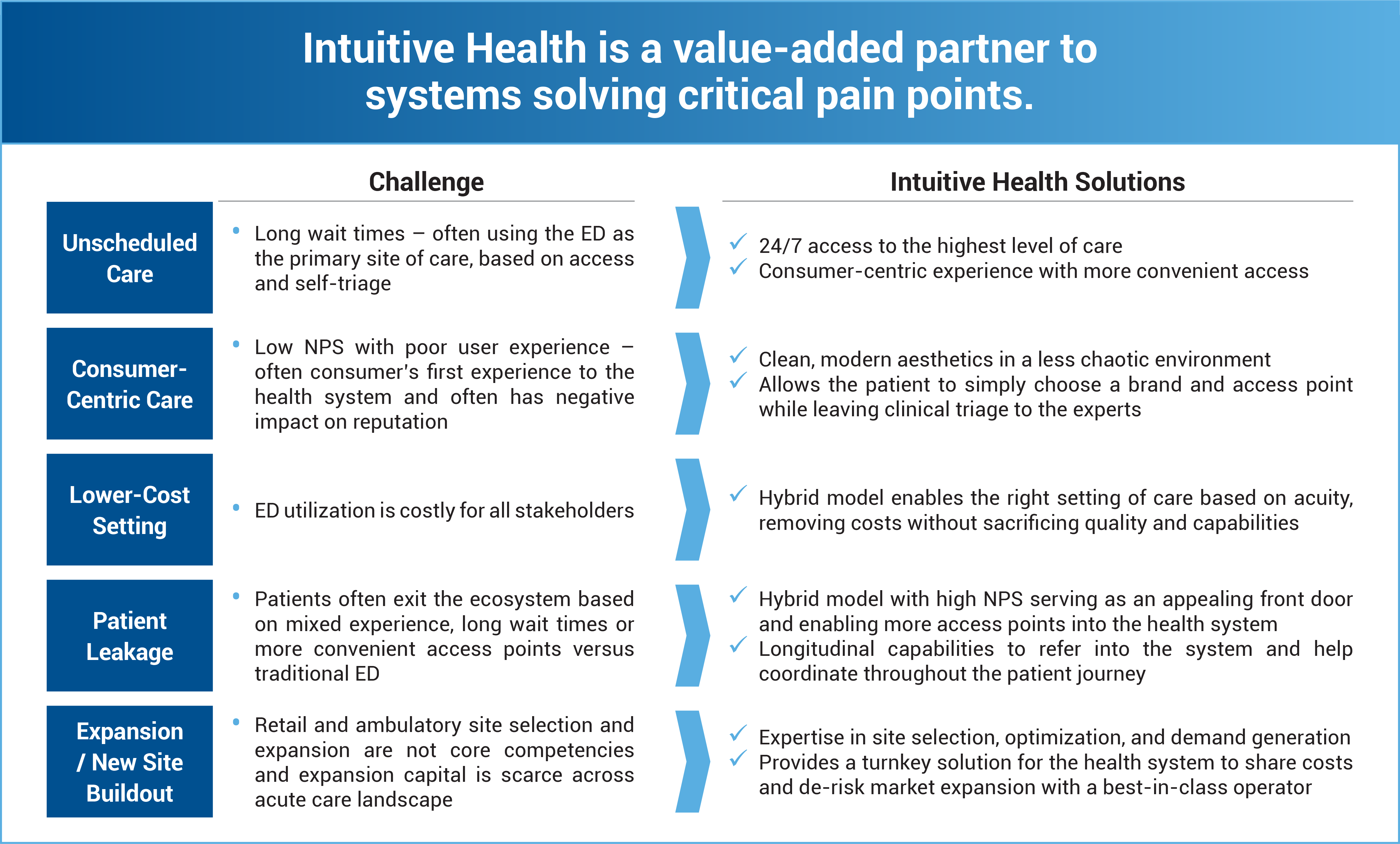Stop losing patients and revenue: Revolutionize on-demand care with a proven ER and urgent care hybrid
Introduction
Urgent care and freestanding emergency (FSED) facility capacity have expanded
rapidly, yet patients still struggle to access the right level of care
at the right time. The Urgent Care Association reports approximately 10,400
urgent care locations in 2021 growing to over 15,000 by January 2025,
delivering more than 250 million visits annually.1 Meanwhile, freestanding emergency departments increased from 50 in 2001 to 841 in 2022, accounting for
over 13.7 million visits per year.2 Despite this growth, misdirected demand persists; non-emergent conditions
land in ERs, emergent needs start in urgent care, and overcrowding, duplicate
billing, and avoidable costs follow. This white paper makes the case for
a hybrid ER and urgent care model that triages seamlessly at the point
of care, reduces inappropriate utilization, and aligns clinical outcomes
with financial efficiency.

Ultimately, urgent care and FSED facilities serve the same purpose: to help patients receive immediate medical attention. Yet confusion too often drives patient behavior. The patient must decide between visiting urgent care with limited capabilities or visiting the ER, where they have access to the highest possible care and the most advanced medical equipment, but where wait times may be significantly longer. Unfortunately, this “better safe than sorry” mentality that leads them to the ER is often not the best approach. The uncertainty and confusion drive unnecessary costs, poor patient experiences and strained operational efficiency. The result? Lost revenue, overcrowded ERs, missed opportunities for health systems and a negative perception of the health system’s brand.
Patients aren’t making the best use of their time and resources. To add insult to injury, when a patient visits a freestanding or satellite ER with a non-emergent condition, they’re still billed at the ER rate. Too many patients leave the facility feeling frustrated and unsatisfied when they should only be worried about receiving the highest quality care.
Historically, telling patients how to choose one type of care over another has not been effective. The best solution is to change the model of care and make the choice of where to receive care as simple as possible.
The hybrid ER and urgent care model transforms how patients access immediate care. By seamlessly combining ER and urgent care services under one roof, this model improves patient outcomes, reduces average wait times, optimizes revenue and reduces systemic inefficiencies. It also bills patients based on acuity and the services that are utilized — rather than point of entry.
The hybrid ER and urgent care model continues to establish a strong position within the broader healthcare system. Here we’ll explore the continued disconnect between traditional ERs and urgent care centers and the benefits of making a seamless transition to combination care for patients, payers and the industry.
When patients make the wrong choice, everyone pays — it doesn’t have to be that way

In the United States, almost 30% of ER visits could have been treated
effectively in a lower-cost urgent care setting.3 These avoidable ER visits inflate costs for payers and patients alike
and bog down ER operations.
Still, patients who can choose between the ER and urgent care find themselves in a quandary: Which level of care do they require? When patients don’t know the level of care they need, they almost always select the higher level, knowing that they will receive care for their condition regardless of whether it’s emergent or non-emergent.
The challenges for today’s ERs
According to the RAND research organization, in 2024, ER visit numbers almost reached pre-pandemic proportions nationally, with the numbers consistently rising between 2020 and 2024.4
- Patient complexity is also on the rise, with ERs managing patients with complex medical and social needs.5
- ER patient acuity is rising, translating to an increase in demand for critical care services in the ER.6
- Increases in demand and insufficient capacity can lead to ER crowding, longer wait times and violence toward ER staff.7
What’s on the line for urgent care centers
Urgent care centers are a great resource as another medical care option. However, if a patient seeks urgent care support and finds out they need a higher level of care, they’re redirected to another facility that can handle the level of care they need. This wastes time that the patient could have spent at the correct facility. In addition, the patient is on the hook for two different billings: one for urgent care and one for the emergency department.
- Similar to ERs, urgent care centers don’t administer specialized care, which means they may refer patients to yet another care facility.
- Reimbursement models may not cover the costs of operating and staffing urgent care centers in sparsely populated rural communities, which may deter operators.
- Wasted money is in the billions and patients lose precious time along the way.
What if the healthcare model could be streamlined and simplified, ensuring patients no longer have to navigate the confusion of choosing the right facility for their needs?
 The hybrid model that works for patients, hospitals and payers
The hybrid model that works for patients, hospitals and payers
Intuitive Health has developed a highly successful healthcare model: a hybrid ER and urgent care facility that combines the emergent and non-emergent environment under one roof. We created the concept in 2008 to improve how patients were treated in the emergency room — leading to better outcomes and improved patient care. The ER and urgent care combination offers value for the money and, at the same time, provides full-service care for the patient’s condition.
No one should have to choose between an ER and urgent care during one of their most vulnerable moments. Because patients are not doctors, many may not understand the level of care their condition requires.
Delivering value where traditional models fall short
Traditional care delivery models struggle to meet today’s on-demand expectations. For instance, standalone urgent care often operates at a loss and fails to reduce ER pressure. Freestanding ERs have limited geographic draw and struggle with low patient volume.
By contrast, the Intuitive Health hybrid model consistently outperforms traditional models. In 2023, the average hybrid ER and urgent care facility under the Intuitive model treated more than 35,000 patients, which is more than twice the volume of a similarly located urgent care8 or FSED9, and saved roughly $8 million for patients and payers in avoidable emergency department spending.
Other benefits of the Intuitive hybrid model:
- Every site is financially viable, with increasing year-over-year return.
- Greater patient volume.
- Higher negotiated rates for urgent care.
- Improved retention and repeat visits.
- Reduced numbers of patients classified as “left without being seen” (LWBS)
Knowing how to leverage a convenient location for the right volume of potential patients is key. Intuitive Health has a proprietary site selection and market analytics methodology that accurately predicts a successful site.
From triage to discharge: Engineered for efficiency
When patients enter a hybrid center, they’re cared for, whatever their medical condition. This alleviates the need for patients to travel from one healthcare facility to another, cuts down on wait times, and, most importantly, eliminates overutilization of the ER, which creates ER cost savings.
By using the hybrid ER patient triage innovation, the emergency medicine physician serves as an objective decision-maker who diagnoses a patient’s condition and recommends the patient’s treatment. The objective measures in the electronic medical record system then determine the appropriate billing classification. Patients are informed of their recommended treatment plans and are informed before services are rendered to ensure they are aware of the billing process. The intention is for patients never to pay for more than the level of care they need, which saves them from unnecessary spending.
As measured by Net Promoter Score (NPS), Intuitive Health patients are much more satisfied with the dual model than other available models. Implementing a system that values servant leadership and customer satisfaction, the Intuitive Health hybrid ER and urgent care model better meets patients’ healthcare needs.
Solving challenges faced by hospitals

Meeting the moment: Hybrid care for risk-based success
Since its inception, Intuitive Health has done healthcare differently with the promise to WOW patients and allow providers to make a difference in their communities and achieve their business goals. To date, the company has partnerships with leading health systems across the country in more than a dozen states. Intuitive Health is also expanding its model to other states over the next several years.
As of July 2025, eighteen health system partners nationwide have successfully implemented this model and have seen higher patient satisfaction and engagement. This isn’t just a concept; it’s a proven system successfully operating in over 30 facilities nationwide and with more than 60 additional facilities in development.
That means Intuitive Health can offer:
- Delivery of this model at scale, with no direct competitors.
- 15+ years of experience.
- A flawless track record: every site opened is successful, no facility has been closed and consistently delivers high patient satisfaction.
Looking ahead: The future of on-demand care
Intuitive Health set out to improve the customer experience and connect with leading healthcare systems to change the way we administer medical care. We are laser-focused on consumer-centric healthcare and a mix of retail and value-based care.
This intention to improve the entire system has led to better patient outcomes and provided healthcare personnel with a better working environment that’s efficient and practical. The proven process ensures patients receive the care they need. Added benefits include less burnout and reduced mental strain of no longer dealing with emergency room trauma conditions daily thanks to clinical and administrative rotations.
As care access evolves, Intuitive Health is prepared to lead the evolution with the proven hybrid model.
About Intuitive Health
Founded in 2008, Intuitive Health pioneered the combined emergency room and urgent care model, setting a new standard for innovation and accessibility in the ambulatory care space. Partnering with leading health systems nationwide, Intuitive Health builds and operates retail healthcare facilities that seamlessly integrate urgent care and emergency services under one roof. This innovative model enhances patient experience, reduces unnecessary emergency care costs, and empowers health systems to expand their market presence. Ranked among the top 1% of global retailers in customer satisfaction, Intuitive Health serves more than 1 million patients annually. For more information, visit IHERUC.com.
To explore partnership opportunities with Intuitive Health, visit IHERUC.com/Connect or contact Marshall Leslie, Chief Growth Officer, at [email protected].
1 https://urgentcareassociation.org/center-counts/
2 https://www.emnet-usa.org/research/studies/
3 Intuitive Health. (2022, October 3). How to Get More Patient Referrals
- Net Promotor Score. https://www.iheruc.com/news/2022/october/how-to-get-more-patient-referrals-net-promotor-s/.
4 Alnasser, Sara, et al. (2023, January 20). Analysis of emergency department
use by non-urgent patients and their visit characteristics at an academic
center. https://pmc.ncbi.nlm.nih.gov/articles/PMC9880025/#:~:text=in%20other%20departments.-,5,%E2%80%9327.1%25%2C%20respectively).
5 Abir, Mahshid, et al. (2025, April 7). Strategies for Sustaining Emergency
Care in the United States. https://www.rand.org/pubs/research_reports/RRA2937-1.html.
6 Ibid.
7 Ibid.
8 https://urgentcareassociation.org/wp-content/uploads/2022/10/Urgent-Care-Fast-Facts.pdf
9 https://www.emnet-usa.org/research/studies/nedi/
